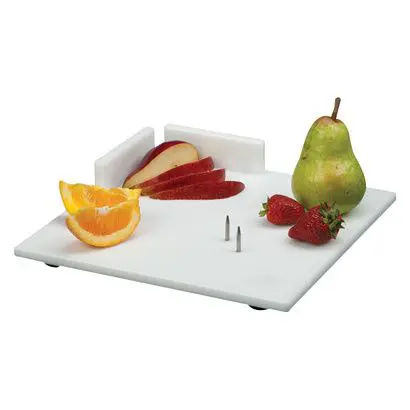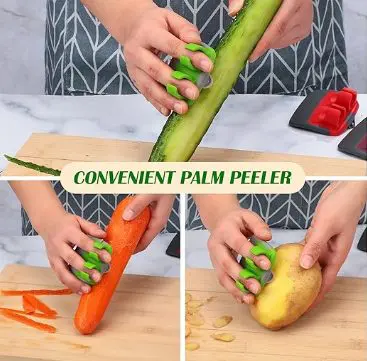Universal Design in Kitchen Utensils
Chop, Chop, Scrap, Scrap, Swish, Swish. Sounds similar to these come from my kitchen many hours a week. Repeat, MANY hours. It dawned on me recently that there’s a great variety displayed in our kitchen utensils, and their quality.
Over the years, I’ve accumulated 4 vegetable (potato) peelers. Not all are created equal. As we age, we can get fussier about the material things around us, and why not? We want reliable, consistent function.
Universal Design
One of those chop/scrap/swish times got me thinking about universal design and Aging in place. No doubt, you’ve read something about universal design in relationship to designing a new house, an updated kitchen, a remodeled bath. The ideas are creative, although often expensive. Luckily, we don’t take on such big projects regularly.
Conversely, I use at least one of those potato peelers for some chore every day. We need a kind of universal design for small utensils and gadgets for easier use. That’s especially so as we age, but really for most ages.
As FLW said about his famous houses and architecture “form follows function.” We want both.
It turns out there is a large array of such items on the market, often called adaptive tools. I just wasn’t paying that much attention. I’m not interested (yet) in all the categories for myself, but I figure we need to consider the future as well as now.
Adaptive Tools
In the kitchen, true universal design would include plans for wheelchair-height counters, accommodating appliances and such. I’m concentrating on ‘adaptive tools’ that are smaller items and cheaper purchases. Ways to immediately make life a bit easier, whether it’s chopping or sawing food, standing more comfortably, opening jars or handling hot pans.
Adaptive tools (as hinted in the name) are meant to adapt to our special needs. Homemaking tasks and meal preparation can become challenging as we age or after injury or illness. There’s no reason not to get a little help.
A friend of mine, the main cook in the house, recently fractured his wrist. Food preparation becomes a much longer ordeal under such circumstances. Any tool that might help is welcomed.
Adaptive Tools for Aging in Place
Whether for ourselves or loved ones, at some time adaptive tools help us “Age in Place.” Accessibility (through modified kitchen items) can increase our independence.
I’m going to keep my eyes open for those that catch my attention in the coming years. For now, I am skipping some of the adaptive tools geared for those in rough shape and instead concentrating on tools helpful to many of us active in our second 50 years.
The missing items include things like the red place settings designed to help those with Alzheimer’s. Did you know that the color red has been shown to increase appetite and food intake of Alzheimer’s patients by 24% and liquid by 84%? For our future reference, that’s pretty interesting and a good thing to remember for loved ones.
Kitchen Gadgets
Here, I’m sharing some favorites I’ve used or want to use. My objective in picking this list is to concentrate on items that DON’T LOOK like they are adaptive to disabilities. Sometimes folks have no choice, but right now I do, and I want nice looking (and functioning) objects. Practically speaking, I want tools for later and for now.
Some of the adaptive tools included below are ones I’ve used or want to purchase. I am not certain that they are in order of preference, so I’ll maintain that there is no particular order at all.
The Mezzaluna (Knife)
I have mentioned this tool before when writing about arthritis, which is aided by the Mezzaluna Knife. My husband and I are suckers for kitchen gadgets and a couple years ago we couldn’t resist a mezzaluna (‘mezza’ meaning half or part and ‘luna’ moon – so half-moon shape). Perhaps, I should have looked into it a bit more before purchasing.
For those who want a description, it is a curved knife with either a single or double blade. Traditionally, the mezzaluna has two handles, which you use with two hands. There is a similar (smaller and popular) product called the “ulu” which originated with the Inuit in Alaska. The ulu is a one-handle tool with the blade attached in two areas. You see these displayed with elegant handles and special cutting bowls.
 Like mine, some of the supposed mezzalunas these days are almost a cross between the traditional and the ulu (so small with one handle). Mine is an inexpensive Kitchenaid model (which came with a protective sheath) and is just big enough to use with two hands, but easy enough with one. Model shown is Amco.
Like mine, some of the supposed mezzalunas these days are almost a cross between the traditional and the ulu (so small with one handle). Mine is an inexpensive Kitchenaid model (which came with a protective sheath) and is just big enough to use with two hands, but easy enough with one. Model shown is Amco.
Online you see people ‘demonstrate’ the products, especially the ulu, by chopping. THAT is missing the point since these are mostly ‘rocking’ tools with very sharp blades. It is not unusual to see mezzalunas that look more like a big log-splitting saw. [See video below.] Typically, you will read that these utensils are for herbs, spices and light veggies (like onions, garlic or greens). That need not be true; even fish, meats or nuts can be on the chopping block. (Or perhaps a rocking block?)
More tips regarding a mezzaluna
Wooden bowls that fit the shape of the mezzaluna or ulu are a big help (especially with nuts) by keeping bits in place. Learn to ROCK not chop; it’s much safer for this sharp knife. It’s a perfect tool for any kind of chilies, or things you don’t want to touch. I’ve used it for cleanly cutting pie or gooey desserts. Lots of people mention pizza and I can confirm it works every bit as good as a pizza cutter. I have heard that in the Netherlands, they use the mezzaluna in cheese shops.
Chefs often demote it in place of a chef’s knife, which they claim can be more “universal.” Nevertheless, there is one situation in which the mezzaluna surpasses a chef’s knife. One of the best things about a mezzaluna is that as you age, if arthritis is present (whether in hand or wrist) the mezzaluna is safer, faster and more comfortable. This goes double if buying a double grip tool. If you have arthritis, consider one; if you don’t have arthritis, get over the learning curve now and consider one.
See the quick YouTube video below using a large mezzaluna to view the rocking motion. [You will get the gist in 10 seconds.] https://youtu.be/6hYy9ulfuVo
The Rocker Knife
 Somewhat related to the mezzaluna above is the category of rocker knives. There are myriad options of these angled cutlery knives. As with a mezzaluna, the idea is to rock rather than chop, helping those with a weak grasp. Most often these ergonomic knives are lightweight with easy to grip handles. (The one shown here is a Sammons Preston).
Somewhat related to the mezzaluna above is the category of rocker knives. There are myriad options of these angled cutlery knives. As with a mezzaluna, the idea is to rock rather than chop, helping those with a weak grasp. Most often these ergonomic knives are lightweight with easy to grip handles. (The one shown here is a Sammons Preston).
I wanted to get the OXO rocker knife with serrated edge, but it appears they no longer make it. They’ve actually discontinued several things I had on my wish list. (As a heads-up, OXO good grip products often win best-in-show, at least on Amercian Test Kitchen.)
Cutting Boards with Added Aids
 Unlike common cutting boards, aided boards are suitable for avoiding accidents for one-handed users and those with a weak grip. Three of their helpful elements are the food spikes used to keep food in places, corner brackets to keep the food from falling off and suction cups to anchor the board while working. Some, like the Etac-30741 Deluxe Plastic One-Handed Kitchen Paring Board, have a vice tool attached making one-handed use much easier. They’re all designed to accommodate both right and left-handed users. [The one shown is the Waterproof Cutting Board with Aluminum Food Spikes by Noth Coast Medical.]
Unlike common cutting boards, aided boards are suitable for avoiding accidents for one-handed users and those with a weak grip. Three of their helpful elements are the food spikes used to keep food in places, corner brackets to keep the food from falling off and suction cups to anchor the board while working. Some, like the Etac-30741 Deluxe Plastic One-Handed Kitchen Paring Board, have a vice tool attached making one-handed use much easier. They’re all designed to accommodate both right and left-handed users. [The one shown is the Waterproof Cutting Board with Aluminum Food Spikes by Noth Coast Medical.]
They can be more expensive than one might expect, but you may find similar products at lower prices. The pictured board can easily be found online for $68 (small) or $87 (large). The vice grip Etac mentioned above was noted at $80. I’ve seen Sammons Preston boards (with nails and corner guards) for around $50.
When cheap cutting boards can be purchase for 5 bucks in any department store, these seem costly. But so is the price for food accidents, whether wasting food or drawing blood.
Pasta Lover Forks
 Without a doubt, I’m a pasta lover (gluten and all). On my first glimpse of a ‘Forghetti’ it made so much sense to me. I do NOT have a set (yet) but can’t figure out why they shouldn’t be a standard. The Forghetti is a stainless steel 7” fork with one edge that offers greater stability for twirling your pasta. It provides better dexterity and management for those with less hand-control, such as those who suffer hand tremors, arthritis or Parkinson’s.
Without a doubt, I’m a pasta lover (gluten and all). On my first glimpse of a ‘Forghetti’ it made so much sense to me. I do NOT have a set (yet) but can’t figure out why they shouldn’t be a standard. The Forghetti is a stainless steel 7” fork with one edge that offers greater stability for twirling your pasta. It provides better dexterity and management for those with less hand-control, such as those who suffer hand tremors, arthritis or Parkinson’s.
There could be a downside I don’t know of yet. Maybe the feel in your mouth? But can’t you just envision how kids would love this option?
[Find Forghetti on Amazon for less than $15 / set of four (they come in small and larger sizes.]
Fatigue Mats for the Kitchen Sink
Not all of my suggestions are meant to be innovations; this is an oldie-but-goodie. And yes, I realize this is not really a utensil, but it remains a great kitchen addition for seniors. If you have trouble standing for long periods, one of these squishy mats can surprise you in how much better if feels on the feet, legs, and/or back. We’ve all experienced the pain or tension from standing on a hard, bare floor. It puts a disagreeable pressure on your body’s entire lower half. Anti-fatigue mats are designed to alleviate that pressure.
Spruce Eats rated the Sky Mat number one. Features they pointed out were thick memory foam, nonslip bottom and anti-trip beveled edge. Humbly, I suggest any such mat should include these features.
Sky Mat is competitive in price, but similar to others. Most mats are easy to clean and come in many different colors, sizes, and prices. The higher end products like GelPro Elite Premium Comfort Anti-Fatigue Floor Mat (Costco sells this too) can run much higher, even at Costco. There are more knock-offs of these products and with a little inspection you can find what you need. Mine either came from Home Depot, Lowes or Costco. Around $25. [Its memory foam evidently didn’t come with a memory aid.  ]
]
Angled Cutting Knives
Strange looks don’t always mean strange function. Here’s another example of a tool that really would work better for everyone.
The grip of these knifes (usually with soft handles) keep the hand in a neutral 90-degree, Stress-free position for both the hand and wrist. It is a particular help to those with weak hand functions. Ergonomically they work much better than our normal straight-edge knives, which are certainly easier to manufacture. The straight-edge cutters stretch the tendons on the upper wrist and compress tissues of lower wrist while we use them. The angled knives generally also have a thicker handle reducing the need to grip so much when faced with wet or greasy situations. There are especially good for shorter folks when prepping at taller work surfaces.
This type of knife comes in many sizes and for various uses (craving, bread or vegetable cutting, even a dinner knife).
The green one shown here is the PETA Easi Grip Carving Knife. (See it at: Buy Peta Easi-Grip Carving Knife, Kitchen Aid (healthproductsforyou.com). The black Etac Ergonomic Relieve Knives function in the same way. Also, the handle top is gently curved to allow for the thumb to rest comfortably. Promoters explain that the blade is very sharp to facilitate cutting a variety of items but lower than the handle, reducing the risk of your hand coming into contact with food – or blade. (see at: Etac Ergonomic Relieve Knives | Performance Health).
Better Jar Openers
 We may ask ourselves if the perfect jar opener exists? As of yet, I’m not convinced. Still here are some options. I’ve skipped any electric versions.
We may ask ourselves if the perfect jar opener exists? As of yet, I’m not convinced. Still here are some options. I’ve skipped any electric versions.
The undercounter mount opener (picture as seen on amazon). This product might be great for those who have the ROOM for an undercounter mount. Not all of us do. Needless to say, I haven’t tried it.
 The OXO has been listed as the best choice by some (such as in the review article below). I don’t have one, although I have many other OXO products that I am pleased with. I suspect it would be the item I would choose if currently in the market.
The OXO has been listed as the best choice by some (such as in the review article below). I don’t have one, although I have many other OXO products that I am pleased with. I suspect it would be the item I would choose if currently in the market.
If you want the best for trouble-free storage, perhaps rubber or silicon grippers are the ticket. Try Human Intention 4pack, for softer and easier to use rubber. While I don’t have these particular grippers, I have several Human Intention products, and all are of high quality.
 Lastly, pictured are two other manual type openers, like the Kuhn Rikon Strain Free Gripper for Jars and Bottles. The two products shown are ones that I own but do not particularly like; nor do I think they are as beneficial to for the senior hand as claimed. They are manual openers, promoted as offering strain-free gripping. I’ve found them disappointing.
Lastly, pictured are two other manual type openers, like the Kuhn Rikon Strain Free Gripper for Jars and Bottles. The two products shown are ones that I own but do not particularly like; nor do I think they are as beneficial to for the senior hand as claimed. They are manual openers, promoted as offering strain-free gripping. I’ve found them disappointing.
To consider you own preference, consult this review article: The 7 Best Jar Openers of 2023 (thespruceeats.com)
Finger Guards
I can’t wait to try something like the ZOCONE Stainless Steel Finger Guard.  As pictured here, the guards are great for anyone with low vision, hand tremors or just nervous around big, sharp knives. I just like the concept of it. The inexpensive product slips around stabilizing fingers while you cut with the other hand. We don’t have to wait until we actually need an adaptive tool to avoid accidental finger cuts. ZOCONE is known for arts & crafts products, but this is a treat for the kitchen. (BTW, I’d be interested in anyone who can find this product someplace other than Amazon.)
As pictured here, the guards are great for anyone with low vision, hand tremors or just nervous around big, sharp knives. I just like the concept of it. The inexpensive product slips around stabilizing fingers while you cut with the other hand. We don’t have to wait until we actually need an adaptive tool to avoid accidental finger cuts. ZOCONE is known for arts & crafts products, but this is a treat for the kitchen. (BTW, I’d be interested in anyone who can find this product someplace other than Amazon.)
Weighted Utensils
 You might share my wonderment of why ‘weighted’ utensils are an adaptive tool. The design evidently provides discreet help for those with tremors or even Parkinson’s. They’re generally wide with nonslip handles and often suggested for those with a weak grip or hand weakness. That’s where my confusion set in. Why would those with weakness want extra weight? Turns out most of these do not actually weigh more than typical utensils, they simply employ a balance that makes them easier to pick up. And for those with tremors the balance of the utensil makes them less frustrating to use. They come in many styles and materials. Shown here is a set of BUNMO Adaptive Utensils – Weighted Knives, Forks and Spoons Silverware Set, selling for around $25.
You might share my wonderment of why ‘weighted’ utensils are an adaptive tool. The design evidently provides discreet help for those with tremors or even Parkinson’s. They’re generally wide with nonslip handles and often suggested for those with a weak grip or hand weakness. That’s where my confusion set in. Why would those with weakness want extra weight? Turns out most of these do not actually weigh more than typical utensils, they simply employ a balance that makes them easier to pick up. And for those with tremors the balance of the utensil makes them less frustrating to use. They come in many styles and materials. Shown here is a set of BUNMO Adaptive Utensils – Weighted Knives, Forks and Spoons Silverware Set, selling for around $25.
Stove Knob Operator
I am putting this in the kitchen section as it is most generally considered for use at the stove; but it can also be used on any non-round control knob or other appliance handles. I think of my own stove as having straight-forward knobs, but for those who experience arthritis or hand  disabilities turning a knob can take more work than I put into it. When this light-weight TKO Turning Knob Operator is pressed down over a knob surface, its pins grasp (and retract) creating a secure grip. This one is from Bel-Art products and lists in the range of $62. However, I’ve seen it for approximately $32 (link below) or even $25, so shop around.
disabilities turning a knob can take more work than I put into it. When this light-weight TKO Turning Knob Operator is pressed down over a knob surface, its pins grasp (and retract) creating a secure grip. This one is from Bel-Art products and lists in the range of $62. However, I’ve seen it for approximately $32 (link below) or even $25, so shop around.
TKO Turning Knob Operator – Turns knobs, faucets, valves and keys (allegromedical.com)
Another Vegetable Peeler?
 I mentioned all my potato peelers. So, I don’t want another one, right? Uh, maybe not. Still, this is interesting. This “multi-function” peeler is designed for those with limited mobility. Unlike our traditional straight peelers or Y-shaped top peelers, it is easier to grip and less risky than a sharper blade. These are also recommended for use along with a one-handed cutting board. I might like to try one of these peelers before actually purchasing it, but if gripping is an issue, it’s an inexpensive purchase at less than $5 apiece. [Don’t pay more, as sets come even less costly per peeler.] Picture as shown on amazon.
I mentioned all my potato peelers. So, I don’t want another one, right? Uh, maybe not. Still, this is interesting. This “multi-function” peeler is designed for those with limited mobility. Unlike our traditional straight peelers or Y-shaped top peelers, it is easier to grip and less risky than a sharper blade. These are also recommended for use along with a one-handed cutting board. I might like to try one of these peelers before actually purchasing it, but if gripping is an issue, it’s an inexpensive purchase at less than $5 apiece. [Don’t pay more, as sets come even less costly per peeler.] Picture as shown on amazon.
Over-the-Top Oven Mitts
 To round out a dozen ideas, I want to include the option of a much better oven mitt than the kind I grew up with, and which we then called ‘potholders.’ Admittedly, I continued to use those childhood type mitts exclusively until sometime during Covid when I started to make sourdough bread. (Yes, I was one of those.) I was taught to use a cast iron pot. Those things are heavy and scary hot. So, my question was, do I buy the new kind of silicon gloves (rated to 500 degrees) or do I actually consider welding gloves (often rated to over 2,000 degrees). To spoil the surprise, I will tell you I tried both. Thus, now the question is what did I stick with?
To round out a dozen ideas, I want to include the option of a much better oven mitt than the kind I grew up with, and which we then called ‘potholders.’ Admittedly, I continued to use those childhood type mitts exclusively until sometime during Covid when I started to make sourdough bread. (Yes, I was one of those.) I was taught to use a cast iron pot. Those things are heavy and scary hot. So, my question was, do I buy the new kind of silicon gloves (rated to 500 degrees) or do I actually consider welding gloves (often rated to over 2,000 degrees). To spoil the surprise, I will tell you I tried both. Thus, now the question is what did I stick with?
Welding gloves are designed for incredibly high temperatures when welding. My husband does a bit of this and these gloves can handle temperatures well beyond what I might experience when my bread is ready to come out. Additionally, some people find the individual fingers more flexible and easier to grasp or maneuver pots or pans (or welding items). But these days both welding and silicone gloves can be found with individual fingers.

My husband offers another tip. He says that the mitts are better for pretending to be Gumby.
So why am I now using silicone gloves? Here’s the kicker. Unlike me, I suggest that if you buy a decent (not necessarily the best, just good) pair of welding gloves, you’re probably better off. Unfortunately, I visited Harbor Freight (a store I actually like), but bought ones not so good and the seams quickly tore. The silicone gloves were a bit more stylish (silly) and less expensive (approximately $15 at the time of purchase). Yet, I admit that the welding gloves are probably the better solution. WHY?
We aren’t going to hold a 2,000-degree pan. So, why would I recommend the welding gloves? As we age, we might move more slowly. As we hold a hot pot or sheet pan longer the heat starts to come through. Silicone gloves are great compared to our childhood mitts (which I still use sometimes of course), but the welding gloves will let us move more slowly without fear of burning. It’s a tradeoff.
One last comment – each of these options, whether silicone, welding, fingers or mitts, they are all big for me, and quite awkward. That’s why my typical childhood pot-holders still make the grade regularly.
See Welding Mitts good for cooking here at Amazon (around $22 at the time of writing). Example of silicone gloves ($20.)
Final Thought
Many of these items, such as angled knives, carrot graters or weighed silverware may need more getting use to than expected. Like me, you may be resistive, especially if you don’t need them yet. Nevertheless, some are good all-around items and it’s nice to know adaptive tools are out there if we do ever require them.
Prices listed were all at the time of writing and can obviously change frequently. Shop well; I love a good deal.
—
Title Photo: Utensils on wood: Image by Lydia from Pixabay
The post Universal Design in Kitchen Utensils appeared first on Aging with Pizzazz.


























